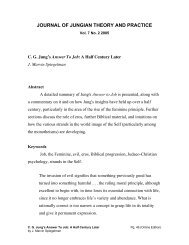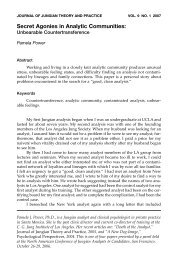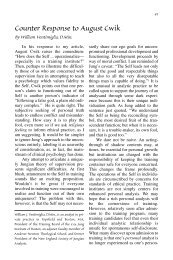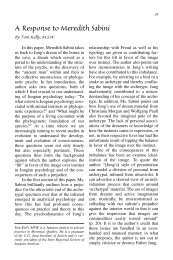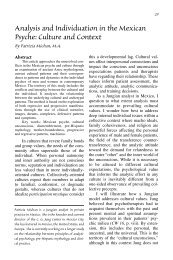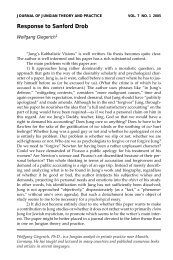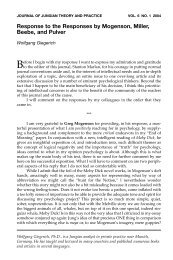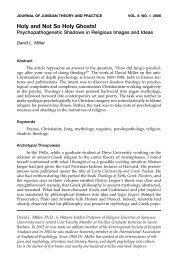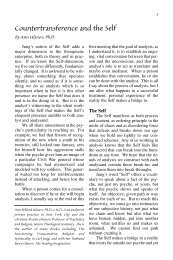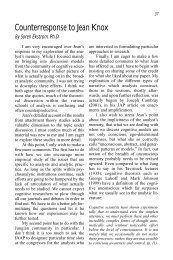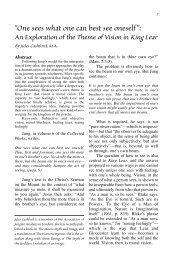The Union of Opposites in the Kabbalah - The new Israeli Jungian ...
The Union of Opposites in the Kabbalah - The new Israeli Jungian ...
The Union of Opposites in the Kabbalah - The new Israeli Jungian ...
You also want an ePaper? Increase the reach of your titles
YUMPU automatically turns print PDFs into web optimized ePapers that Google loves.
68 <strong>The</strong> <strong>Union</strong> <strong>of</strong> <strong>Opposites</strong> <strong>in</strong> <strong>the</strong> <strong>Kabbalah</strong><br />
In <strong>the</strong> poem, <strong>the</strong> two protagonists are equals. <strong>The</strong>ir names, Shulammite and<br />
Shlomoh, derive from <strong>the</strong> Hebrew root sh-l-m that denotes both peace and wholeness.<br />
<strong>The</strong> dual nature <strong>of</strong> <strong>the</strong>ir names, simultaneously private and transpersonal,<br />
turns <strong>the</strong>m <strong>in</strong>to a qu<strong>in</strong>tessential embodiment <strong>of</strong> <strong>the</strong> man-woman relationship. <strong>The</strong><br />
Shulammite enchants Shlomoh, who describes her beauty <strong>in</strong> strik<strong>in</strong>gly rich and<br />
poetic terms through metaphors borrowed from nature that allude to earthl<strong>in</strong>ked,<br />
symbolic, and archetypal aspects. <strong>The</strong> lover is carried away by <strong>the</strong> collective<br />
unconscious <strong>in</strong>to <strong>the</strong> realm <strong>of</strong> <strong>the</strong> animus and anima union. Regardless <strong>of</strong> <strong>the</strong><br />
read<strong>in</strong>g one chooses, <strong>the</strong> Song <strong>of</strong> Songs shows that <strong>the</strong> union <strong>of</strong> man and woman<br />
can be an experience <strong>of</strong> <strong>the</strong> paradox <strong>of</strong> <strong>the</strong> Self, that is, <strong>the</strong> conjunction <strong>of</strong> opposites.<br />
<strong>The</strong> result <strong>of</strong> this experience is <strong>the</strong> sense <strong>of</strong> Oneness, a feel<strong>in</strong>g <strong>of</strong> peace with<br />
oneself and with <strong>the</strong> world.<br />
<strong>The</strong> Partsufim Doctr<strong>in</strong>e: Countenances or Archetypal Images<br />
About four hundred years ago <strong>in</strong> Safed, Isaac Luria <strong>in</strong>troduced a <strong>new</strong> system<br />
to describe processes with<strong>in</strong> <strong>the</strong> Godhead that <strong>in</strong>volve Partsufim, or, psychologically<br />
speak<strong>in</strong>g, archetypal images <strong>in</strong> human form. Whereas <strong>the</strong> ten Sephiroth,<br />
<strong>the</strong> older system <strong>of</strong> godly emanation, had represented abstract concepts, <strong>the</strong> five<br />
Partsufim are personalized. <strong>The</strong> <strong>in</strong>teraction between <strong>the</strong>m is mythical and thus<br />
closer to psychological understand<strong>in</strong>g. <strong>The</strong> concept appears <strong>in</strong> <strong>the</strong> Zohar. Scholem<br />
(1946) notes that anthropomorphic thought w<strong>in</strong>s here its greatest victory <strong>in</strong> <strong>the</strong><br />
history <strong>of</strong> Jewish mysticism and “<strong>the</strong>se symbols reflect highly developed mystical<br />
meditations...almost impenetrable to rational thought...this symbolism is <strong>of</strong> a<br />
somewhat crude texture” (pp. 269–273). For Scholem, <strong>the</strong> symbols <strong>of</strong><br />
“Mo<strong>the</strong>r,””Fa<strong>the</strong>r,” “Son,” and “Daughter” <strong>in</strong> <strong>the</strong> Partsufim myth are crude by<br />
comparison to <strong>the</strong> abstract concept <strong>of</strong> div<strong>in</strong>e emanation <strong>in</strong> <strong>the</strong> Sephirot.<br />
<strong>The</strong>re are five major Partsufim. Keter (1) is now Arikh Anp<strong>in</strong>, “<strong>the</strong> Long<br />
Suffer<strong>in</strong>g,” represent<strong>in</strong>g pure mercy and div<strong>in</strong>e love. (In <strong>the</strong> Zohar, Arikh Anp<strong>in</strong> is<br />
also called Attika Kadisha, <strong>the</strong> Holy Ancient One.) This is <strong>the</strong> highest sefirah. Arikh<br />
Anp<strong>in</strong> also means slow to anger, namely, patient (from <strong>the</strong> Aramaic root Anaf and<br />
<strong>the</strong> Hebrew root Af, mean<strong>in</strong>g anger). He is also a grandfa<strong>the</strong>r, as is Keter. Hokhmah<br />
(2) and B<strong>in</strong>ah (3) become <strong>the</strong> Partsufim <strong>of</strong> fa<strong>the</strong>r and mo<strong>the</strong>r, Abba and Ima. <strong>The</strong>y<br />
are separated, but jo<strong>in</strong>ed <strong>in</strong> an eternal union (zivug). Ze`ir Anp<strong>in</strong> (4) comprises <strong>the</strong><br />
six lower Sephiroth and means <strong>the</strong> short face or <strong>the</strong> short nose, <strong>the</strong> impatient, as<br />
opposed to Arikh Anp<strong>in</strong>. He is <strong>the</strong> son. Nukvah (5) (<strong>the</strong> fem<strong>in</strong><strong>in</strong>e) is Malkhut, <strong>the</strong><br />
tenth sefirah. She is both <strong>the</strong> daughter and <strong>the</strong> son’s consort.<br />
Follow<strong>in</strong>g is a diagram <strong>of</strong> <strong>the</strong> Partsufim scheme:<br />
Arikh Anp<strong>in</strong> - Keter (1)<br />
(Grandfa<strong>the</strong>r)<br />
Ima - B<strong>in</strong>ah (3) Abba - Hokhmah (2)<br />
(Mo<strong>the</strong>r)<br />
(Fa<strong>the</strong>r)<br />
Nukvah - Malkhut (5) Ze`ir Anp<strong>in</strong> - Hesed D<strong>in</strong> Tifereth (4)<br />
(Daughter)<br />
(Son) Netsah Hod Yesod



